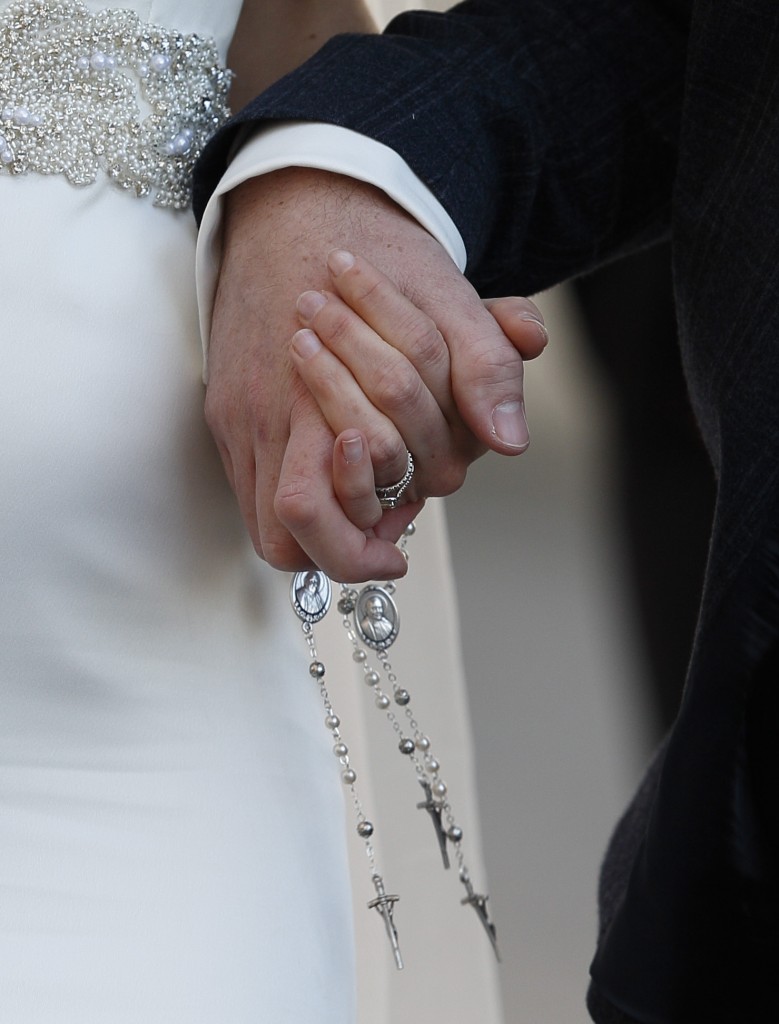
A newly married couple hold rosaries in their hands as they leave Pope Francis’ general audience in St. Peter’s Square at the Vatican Feb. 24. (CNS photo/Paul Haring) See POPE-AUDIENCE-POWER Feb. 24, 2016.
For the final February reflection on complementarity, MUR looks to Sr. Prudence Allen’s article, “Man-Woman Complementarity: The Catholic Inspiration” for insight. Allen is one of the most influential Catholic theologians in this particular area, and this article focuses on the historical development of the concept of integral complementarity which was mentioned last week.
Integral complementarity holds together the two elements of identity (equal dignity) and difference when it comes to the sexes. Allen writes, “When one of the two fundamental principles of gender relation—equal dignity and significant difference—is missing from the respective identities of man and woman, the balance of a complementarity disappears into either a polarity or unisex theory.”[i] Balance is a key word to keep in mind whenever the issue of complementarity arises.
Allen reviews briefly the historical development of theories on gender and sexual difference, pointing out that “fractional complementarity” (such as Plato’s idea of two “halves”) easily leads to stereotypes of what a man or a woman should do or is capable of, usually placing men in a superior position. On the other hand, ideologies like Marxism reject any acknowledgment of difference in preference of a unisex approach. Radical feminism seems to go in both directions at various times, taking a more fractional view in order to place women above men, or looking to abolish (forcibly, if necessary) any difference between the sexes.
To look at a Catholic understanding, Allen turns to Edith Stein (St. Teresa Benedicta of the Cross) and Dietrich von Hildebrand. Stein sees that the bodily difference between male and female is but a fraction of the whole picture, and that the true difference is metaphysical, since “Matter serves form, not the reverse.”[ii] Pointing out that a woman is created in such a way as to support life from within while a man does so in a detached form leads, Stein believes, to a fundamentally different experience of the world. She sees this as a woman being inwardly receptive and more personal and holistic in her thinking while a man is more outwardly focused and compartmentalized in his thinking. Allen notes that Stein’s thought has some weaknesses as to particular characteristics of masculinity and femininity, but she made a large contribution. Von Hildebrand emphasizes, like Stein, the metaphysical dimension of complementarity. Both man and woman are complete persons, in no way incomplete if they are not married, for example. When a man and a woman come together, though, “the effect is synergetic” and something new happens. Allen describes this with the formula 1+1à3.[iii] It is worth noting that this is not limited to the gift of a child (as wonderful as that is!) but applies in all areas where collaboration results in something that is greater than the sum of its parts.
The rest of Allen’s article (which I encourage you to read in full) is a survey of the excellent and unparalleled contributions of Pope St. John Paul II to this field of knowledge. His work deepened complementarity to the ontological level—in other words, he saw the difference between man and woman at the level of being, at the very center of their existence.
In conclusion, Allen writes that while the world and secular society vacillate between the two poles of polarity and sameness, the Catholic faith steps in to offer an integrated view in which man and woman are called together to “transform the world through a new evangelization of cooperation and interpenetrating work.”[iv]
[i] Prudence Allen, RSM, “Man-Woman Complementarity: The Catholic Inspiration” in Logos 9:3 (Summer 2006), p. 87.
[ii] Ibid, p. 93.
[iii] Ibid, p. 95.
[iv] Ibid, p. 105.
Leave a Reply